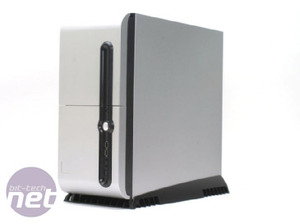
Results
Noise is the next test that we subjected the Silentium T2 too. This test is my personal favourite too as all it requires me to do is sit next to the PC while it does some basic tasks, such as copying ATI drivers from the bit-tech network, and listen.Sometimes, if Tim happens to be looking and I want to seem like I’m working, I’ll write something down. “Quiet”, “Loud” or “OMGWINDTUNNEL” are the descriptions which usually grace my notepad. The question is, which description did I write down regarding the Silentium T2?
“Quiet, but…” is probably the best description here because, while the Silentium T2 is certainly a very stealthy machine, it’s by no stretch of the imagination as silent as the design compromises might justify - that description is a overall judgement too, so when the system is running idle you can expect it to be pretty quiet.
Don’t get us wrong – the Silentium T2 is definitely quieter than other, more expensive cases we’ve seen, but the question that bothers us is whether it’s actually worth it.
In getting the machine this quiet—and again, it’s hardly truly silent—there’s been a huge trade off with build quality, ease of installation and features. Hopefully though, the thermal testing results should give us a wee dram more of good news.

Thermal testing results for the Silentium T2 ECO 80
Parts of that PC are getting fairly warm and the case is still a tiny bit warmer than other cases we've looked at in the past, but it's worth bearing in mind that this is a pretty small case and the results are still not high enough to cause system instabilities by a long shot - so it isn't anything really worth worrying about. It's also worth pointing out that the fans here are temperature controlled, up to a maximum of 1,900RPM when the temperatures get higher. That's a pretty good speed for fans of this size and the system means that the case should never get so hot that it puts the hardware in peril.
The Silentium T2 ECO 80 makes a lot of bold claims on the packaging about how excellent the cooling system is at pulling cold air in through the middle of the case and then funnelling it over the components and out the top of the case. Unfortunately, the system isn't as powerful as it might sound so - the result is an average performance.
Conclusions
In the words of Sam Beckett: “Oh, boy.”Really, it’s hard to know where to begin with a case like the Silentium T2 ECO 80. On paper, Arctic Cooling’s intentions are clearly good and aimed in all the right directions. The idea of using rubber around the fans to prevent vibration and using heatsinks instead of fans to cool the HDD is fine and we of course love anything that can help make computing a more environmentally friendly hobby.
The real problem though is that the execution is terrible and the finished product is really just a mish-mash of ruined ideas. On some level it’s actually quite depressing and there’s a distinct feeling that if the Silentium T2 was a person then it’d be a bright and promising young student who got tragically mauled by a sledgehammer-wielding Rottweiler. (Joe, your imagination worries me –Ed.)
The whole case just stinks of good ideas gone wrong and bad ideas left to run rampant. In the end, with a number of structural problems and a generally unappealing look it’s hard to recommend the T2 to anyone. A shame.
- Features
- x
- x
- x
- x
- x
- -
- -
- -
- -
- -
- 5/10
- Build Quality
- x
- x
- -
- -
- -
- -
- -
- -
- -
- -
- 2/10
- Ease of Use
- x
- x
- x
- -
- -
- -
- -
- -
- -
- -
- 3/10
- Performance
- x
- x
- x
- x
- x
- -
- -
- -
- -
- -
- 5/10
- Value
- x
- x
- x
- x
- -
- -
- -
- -
- -
- -
- 4/10
- Overall
- x
- x
- x
- -
- -
- -
- -
- -
- -
- -
- 3/10

MSI MPG Velox 100R Chassis Review
October 14 2021 | 15:04










Want to comment? Please log in.